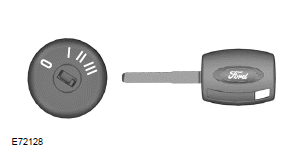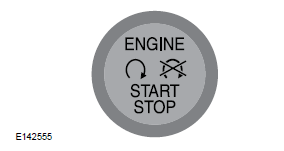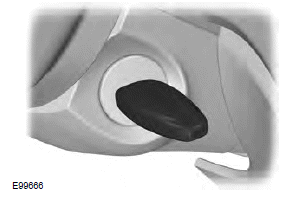
Ford Fiesta: Starting and Stopping the Engine
Ford Fiesta 2009-2019 Owners Manual
General Information
WARNINGS
Extended idling at high engine speeds can produce very high temperatures in the engine and exhaust system, creating the risk of fire or other damage.
Do not park, idle or drive your vehicle on dry grass or other dry ground cover. The emission system heats up the engine compartment and exhaust system, creating the risk of fire.
Do not start the engine in a closed garage or in other enclosed areas.
Exhaust fumes can be toxic. Always open the garage door before you start the engine.
If you smell exhaust fumes inside your vehicle, have your vehicle checked by an authorized dealer immediately. Do not drive your vehicle if you smell exhaust fumes.
If you disconnect the battery, your vehicle may exhibit some unusual driving characteristics for approximately 5 miles (8 kilometers) after you reconnect it. This is because the engine management system must realign itself with the engine. You can disregard any unusual driving characteristics during this period.
The powertrain control system meets all Canadian interference-causing equipment standard requirements regulating the impulse electrical field or radio noise.
When you start the engine, avoid pressing the accelerator pedal before and during operation. Only use the accelerator pedal when you have difficulty starting the engine.
Ignition Switch

0 (off) - The ignition is off.
Note: When you switch the ignition off and leave your vehicle, do not leave your key in the ignition. This could cause your vehicle battery to lose charge.
Note: To switch the engine off when your vehicle is moving, move the transmission selector lever to position N. Use the brakes to bring the vehicle to a safe stop. After your vehicle has stopped, switch the engine off and move the transmission selector lever to position P. Turn the key to position 0 or I.
I (accessory) - Allows the electrical accessories such as the radio to operate while the engine is not running.
Note: Do not leave the ignition key in this position for too long. This could cause your vehicle battery to lose charge.
II (on) - All electrical circuits operational.
Warning lamps and indicators are illuminated.
III (start) - cranks the engine. Release the key as soon as the engine starts.
Keyless Starting (If equipped)
WARNING
The system may not function if the key is close to metal objects or electronic devices such as cell phones.
Note: The ignition will automatically switch off when you leave your vehicle unattended.
This is to prevent your vehicle battery running out of charge.
Note: A valid key must be located inside your vehicle to switch the ignition on and start the engine.
Ignition On
Press the START button once. It is located on the instrument panel near the steering wheel. All electrical circuits and accessories are operational and the warning lamps and indicators will illuminate.

Starting with Manual Transmission
Note: Releasing the clutch pedal while the engine is starting will stop the engine cranking and return to ignition on.
1. Fully depress the clutch pedal.
2. Briefly press the button.
Starting with Automatic Transmission
Note: Releasing the brake pedal while the engine is starting will stop the engine cranking and return to ignition on.
1. Move the transmission selector lever to position P or N.
2. Fully depress the brake pedal.
3. Briefly press the button.
Failure to Start
All Vehicles
The system will not function if:
- The key frequencies are jammed.
- The key battery has no charge.
If you are unable to start your vehicle, do the following.

1. Hold the key next to the steering column exactly as shown.
2. With the key in this position you can use the button to switch the ignition on and start your engine.
Manual Transmission
Note: Releasing the clutch pedal while the engine is starting will stop the engine cranking and return to ignition on. A message will be shown in the display.
If the engine does not crank when the clutch pedal has been fully depressed and the button is pressed:
1. Fully depress both the clutch and brake pedals.
2. Press the button until the engine starts.
Stopping the Engine with Your Vehicle Stationary
Note: The ignition, all electrical circuits warning lamps and indicators will be switched off.
Manual Transmission
Briefly press the button.
Automatic Transmission
1. Move the transmission selector lever to position P.
2. Press the button.
Stopping the Engine When Your Vehicle is Moving
WARNING
Switching off the engine when the vehicle is still moving will result in a loss of brake and steering assistance.
The steering will not lock, but higher effort will be required. With the ignition switched off some electrical circuits, warning lamps and indicators may also be off.
1. Press and hold the button for at least one second or press it three times within two seconds.
2. Move the transmission selector lever to position N and use the brakes to bring your vehicle to a safe stop.
3. When your vehicle has stopped, move the transmission selector lever to position P or N and switch the ignition off.
Starting a Gasoline Engine
Note: You can only operate the starter for a limited period of time, for example 10 seconds. The number of start attempts is limited to approximately six. If you exceed this limit, the system will not allow you to try again until a period of time has elapsed, for example 30 minutes.
When you start the engine, the idle speed increases, this helps to warm up the engine. If the engine idle speed does not slow down automatically, have your vehicle checked by an authorized dealer.
Before starting the engine check the following:
- Make sure all occupants have fastened their safety belts.
- Make sure the headlamps and electrical accessories are off.
- Make sure the parking brake is on.
- Move the transmission selector lever to position P (automatic transmission) or neutral (manual transmission).
- Turn the ignition key to position II. If your vehicle is equipped with a keyless ignition, see the following instructions.
Cold or Hot Engine
Vehicles with Manual Transmission
Note: Do not touch the accelerator pedal.
Note: Releasing the clutch pedal while the engine is starting will stop the engine cranking and return to ignition on.
1. Fully depress the clutch pedal.
2. Start the engine.
Vehicles with Automatic Transmission
Note: Do not touch the accelerator pedal.
1. Move the transmission selector lever to position P or N.
2. Start the engine.
All Vehicles
If the engine does not start within 10 seconds, wait for a short period and try again.
If the engine does not start after three attempts, wait 10 seconds and follow the flooded engine procedure.
If you have difficulty starting the engine when the temperature is below -13ºF (-25ºC), press the accelerator pedal to the mid-way point of its travel and try again.
Flooded Engine
Vehicles with Manual Transmission
1. Fully depress the clutch pedal.
2. Fully depress the accelerator pedal and hold it there.
3. Start the engine.
Vehicles with Automatic Transmission
1. Move the transmission selector lever to position P or N.
2. Fully depress the accelerator pedal and hold it there.
3. Start the engine.
All Vehicles
If the engine does not start, repeat the cold or hot engine procedure.
Engine Idle Speed after Starting
The speed at which the engine idles immediately after starting is optimized to minimize vehicle emissions and maximize cabin comfort and fuel economy.
The idle speed will vary depending on certain factors. These include vehicle component and ambient temperatures as well as electrical and climate system demands.
Failure to Start
Vehicles with Manual Transmission
If the engine does not crank when the clutch pedal has been fully depressed and the ignition key is turned to position III.
1. Fully depress the clutch and brake pedals.
2. Turn the key to position III until the engine has started.
Switching Off the Engine
Vehicles With a Turbocharger
WARNING
Do not switch the engine off when it is running at high speed. If you do, the turbocharger will continue running after the engine oil pressure has dropped to zero. This will lead to premature turbocharger bearing wear.
Release the accelerator pedal. Wait until the engine has reached idle speed and then switch it off.
Engine Block Heater (If equipped)
WARNINGS
Failure to follow engine block heater instructions could result in property damage or serious personal injury.
WARNINGS
Do not use your heater with ungrounded electrical systems or two-pronged adapters. There is a risk of electrical shock.
Note: The heater is most effective when outdoor temperatures are below 0ºF (-18ºC).
The heater acts as a starting aid by warming the engine coolant. This allows the climate control system to respond quickly. The equipment includes a heater element (installed in the engine block) and a wire harness. You can connect the system to a grounded 120-volt AC electrical source.
We recommend that you do the following for a safe and correct operation:
- Use a 16-gauge outdoor extension cord that is product certified by Underwriter's Laboratory (UL) or Canadian Standards Association (CSA). This extension cord must be suitable for use outdoors, in cold temperatures, and be clearly marked Suitable for Use with Outdoor Appliances. Do not use an indoor extension cord outdoors. This could result in an electric shock or become a fire hazard.
- Use as short an extension cord as possible.
- Do not use multiple extension cords.
- Make sure that when in operation, the extension cord plug and heater cord plug connections are free and clear of water. This could cause an electric shock or fire.
- Make sure your vehicle is parked in a clean area, clear of combustibles.
- Make sure the heater, heater cord and extension cord are firmly connected.
- Check for heat anywhere in the electrical hookup once the system has been operating for approximately 30 minutes.
- Make sure the system is unplugged and properly stowed before driving your vehicle. Make sure the protective cover seals the prongs of the block heater cord plug when not in use.
- Make sure the heater system is checked for proper operation before winter.
Using the Engine Block Heater
Make sure the receptacle terminals are clean and dry prior to use. Clean them with a dry cloth if necessary.
The heater uses 0.4 to 1.0 kilowatt-hours of energy per hour of use. The system does not have a thermostat. It achieves maximum temperature after approximately three hours of operation.
Using the heater longer than three hours does not improve system performance and unnecessarily uses electricity.
Other info:
Chevrolet Sonic. Detecting the Vehicle Ahead
The green vehicle ahead indicator will appear when a vehicle is detected ahead.
Whenever this indicator does not appear, FCA will not respond. The indicator may
disappear on curves, highway exit ...
Skoda Fabia. Voice control
Dialogue
The period of time during which the system is ready to receive voice commands
and to carry them out is called a dialogue. The system gives audible
feedback and guides you if necessary thro ...
Honda Fit. If the TPMS Indicator Comes
U.S. models
■ Reasons for the indicator to come on
• Comes on when there is a problem with the TPMS.
• If the compact spare is installed, the indicator comes on after driving
for a few ...
Manuals For Car Models
-
 Chevrolet Sonic
Chevrolet Sonic -
 Citroen C3
Citroen C3 -
 Fiat Punto
Fiat Punto -
 Honda Fit
Honda Fit -
 Mazda 2
Mazda 2 -
 Nissan Micra
Nissan Micra -
 Peugeot 208
Peugeot 208 -
 Renault Clio
Renault Clio -
 Seat Ibiza
Seat Ibiza -
 Skoda Fabia
Skoda Fabia - Honda Pilot
- Volkswagen ID4
- Toyota Prius


